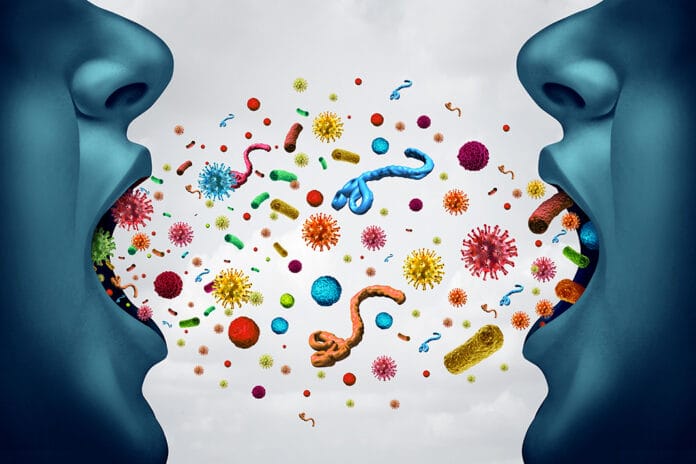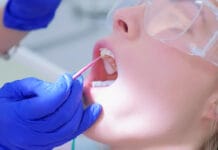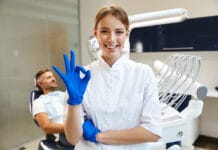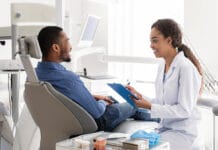Thankfully, we are learning all sorts of great information about keeping bacteria at bay in the dental office. The roadmap to cleanliness in the dental practice is quite clear ‒ hand hygiene, water line maintenance, and sterilization. As they say, cleanliness is next to godliness and ethical standards.
I am not by nature a germaphobe. I should probably have more of a concern about germs, but I usually close my eyes and ears to all the minute details about the places bugs are lurking. When I travel, though, all bets are off. You really don’t know about people these days, and we are in a pandemic after all.
I don’t want to sound judgy as I simultaneously look down at my computer, finding all sorts of crumbs on the keyboard. My very dated Mac is a bit of a hot mess. This is now leading to frantic Google searches about computer bacteria, prompting mass information and the discovery that our desks are one of the buggiest areas in our home. I would have thought this at a public office but surely not in my Anne cave.
I needed to heed the recommendations and begin to use an antibacterial wipe daily. Insert hysterical laugh upon realizing that my entire desk needs to be sanitized. My tabletop temple is one of the largest messes I create and continue to develop daily. I am not sure what I would wipe ‒ papers, books, files? The room is spinning.
Germs are Everywhere
The National Sanitation Foundation (NSF) was established in 1944 as a nonprofit to certify and write safety standards in sanitation and food safety. In 2011, researchers and microbiologists at the NSF did a germ study testing everyday items in homes for bacteria, yeast, and molds.1 Not surprisingly was the kitchen sponge/dish rag and cutting boards. Added to the list were the actual kitchen sink, toothbrush holder, the pet bowl, which was the fourth germiest place in the home, coffee reservoir, faucet handles and stove knobs, pet toys which were a source of coliform bacteria, including staph bacteria, yeast, and mold. Countertops came in with 30% of homes tested to have coliform bacteria. These bacteria are rod-shaped gram-negative, and E. coli is a major species in this group of bugs.
Water dispensers are a hot spot. I have watched news reports when they alert us to restaurants getting busted for unhygienic practices that seem to include the iced tea dispensers too. I love a good Texas tea. Back to the house. Cleaning the hotbed for bacteria on the refrigerator spouts or coffee dispenser should probably include a white vinegar clean and flush. Most of the infractions are in the kitchen, as I am noting. But, seriously, they listed the dishwasher! I am trying for the love of Pete to do the right thing, and now they are telling me I need to wash my dishwasher. Who knew?
The rubber kind of spatulas that have two parts is a disease mecca. You are supposed to separate to clean. They aren’t made to come apart unless they are broken. So, now what? The suggestion is to use metal, but then cookware says no deal.
My head is exploding.
Listing garbage cans is a little silly, don’t you think? Even I had that figured out. In our house, it is a sexist man’s job. I will argue this point because trash cans are near the garage, and the garage is his happy place.
Reusable water bottles. My boy is in college, and this one scares the pants off me. He owns the bottle brushes, but does he use them? A little bacteria can help the gut, right? Speaking of college kids, shower curtains. A study conducted by SafeHome found that your shower curtain can hold up to 60 times more bacteria than your toilet seat.2 Hello Amazon, can you send me dozen shower curtains to my son’s dorm stat!
Let’s talk fruit bowls ‒ the beautiful decorative additions to our kitchens. The harvesting and transportation of fruit involve lots of hands, mud, manure, and chemicals ‒ how delicious! People, listen up! Wash your fruit, and make sure you clean your fruit bowl.
Remote controls. This is a discussion that we have all talked about in hotels. They even put them in plastic bags sometimes. In my house, this isn’t a big concern for me personally. Maybe my husband, though, since he is the only one who touches it.
Trivia about Bacteria
We can’t throw all bacteria under the bus. Some bacteria, of course, are important. Recent research found high-affinity methanotrophs (HAMs) bacteria that eat methane. They were identified in Arctic mineral soils and found in environments like rice paddies, hot springs, mud pots, and peatlands. Methane produced in the soil gets trapped between particles, and then the HAMs consume the gas, preventing the release of methane into the atmosphere. Interesting. If we can harness these friends in our pursuit to reduce global warming, wouldn’t that be terrific?3
How about some bacteria trivia? How well do you know your creatures?
- Clostridium botulinum, the bug responsible for botulism, can survive boiling water.
- The Dead Sea hosts bacteria now! Prokaryote bacteria is clinging to rocks at the bottom of the sea and handling the extremely salty waters famously. They may need to change the name from the Dead Sea to a Little Bit Alive Sea.
- Ugh, the 11s. The glabella between the eyebrows houses a monster bacteria named Demodex folliculorum (aka eyelash mites).
- NASA is super proud of their “clean rooms.” But they were invaded with a new genus of a bug named Tersicoccus phoenicis. This participant has a reputation for outwitting the best sterilization procedures.
- Putting our food in the freezer is to prevent it from spoiling. Freezing may not be safe. Microbes are lasting millions of years in Antarctica. The estimate is that the entire microbial cell population encased in the ice sheets outnumber the human population of Earth more than 10,000 times over.
- 17,000 bacterial gene copies found on high schoolers’ cell phones (and, yes, our mobile devices carry 10 times more bacteria than a toilet seat).4 I wouldn’t offer to hand your patient’s cell phone to them.
- Biodiverse belly buttons. There was a project with the same name that found 2,368 different bacterial species in belly buttons.5 Makes you think, doesn’t it? Putting some icing on that thought is what chemist Christina Agapakis and odor expert Sissel Tolaas did. They used belly button microbes to make cheese.
Whether you are making cheese or making the house smell like vinegar, germs are everywhere and very interesting. It isn’t prudent to wrap up our kids or ourselves in a protective bubble and have no exposure. A little dirt or germs don’t hurt and can be quite useful.
Research suggests that higher levels of exposure to common everyday bacteria and microbes may play a helpful role in the development of the body’s inflammatory systems, which plays a crucial role in the immune system’s fight against infection.6 We do, however, need to pay attention and be smart.
Dr. Charles Gerba, aka “Dr. Germ” from the University of Arizona, did a study of the surfaces in our everyday lives with the highest rate of contamination. It was conducted by trained hygienists, not the tooth kind, in high-traffic locales like Atlanta and Dallas. Some common public spaces to pick up some germs include:
- 71% of gas pump handles
- 68% of mailbox handles
- 43% of escalator rails
- 41% of ATM buttons
- 35% of crosswalk and vending machine buttons
It looks like trying to get to work is far more dangerous than being at our work. I have a lot of pride that we in dentistry strive to have clean, safe environments for not only our patients but for the staff too. Now, where is a disinfectant wipe for my desk?
Need CE? Check Out the Self-Study CE Courses from Today’s RDH!
Listen to the Today’s RDH Dental Hygiene Podcast Below:
References
- Costello, M. (2021, February). Clean the Gerimiest Home Items. NSF International. Retrieved from https://www.nsf.org/blog/consumer/clean-germiest-home-items
- Bathroom Bacteria Germ Statistics for 2021. (2021, June 31). SafeHome. Retrieved from https://www.safehome.org/resources/germs-in-your-bathroom/
- Oh, Y., Zhuang, Q., Liu, L. et al. Reduced Net Methane Emissions due to Microbial Methane Oxidation in a Warmer Arctic. Nat. Clim. Chang. 2020; 10: 317–321. Retrieved from https://doi.org/10.1038/s41558-020-0734-z
- Kõljalg, S., Mändar, R., Sõber, T., Rööp, T., Mändar, R. High Level Bacterial Contamination of Secondary School Students’ Mobile Phones. Germs. 2017; 7(2): 73-77. doi:10.18683/germs.2017.1111. Retrieved from https://www.ncbi.nlm.nih.gov/pmc/articles/PMC5466825/
- Dumke, K. (2013, May 22). Belly Button Biodiversity. National Geographic. Retrieved fromhttps://www.nationalgeographic.org/article/belly-button-biodiversity/
- McDade, T.W., Rutherford, J., Adair, L., Kuzawa, C.W. Early Origins of Inflammation: Microbial Exposures in Infancy Predict Lower Levels of C-reactive Protein in Adulthood. Proc Biol Sci. 2010; 277(1684): 1129-1137. doi:10.1098/rspb.2009.1795. Retrieved from https://pubmed.ncbi.nlm.nih.gov/20007176/












